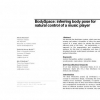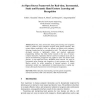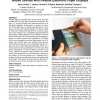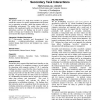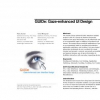435 search results - page 16 / 87 » Interacting with the Computer Using Gaze Gestures |
CHI
2007
ACM
16 years 7 days ago
2007
ACM
We describe the BodySpace system, which uses inertial sensing and pattern recognition to allow the gestural control of a music player by placing the device at different parts of t...
127
click to vote
HCI
2009
14 years 9 months ago
2009
Real-time, static and dynamic hand gesture learning and recognition makes it possible to have computers recognize hand gestures naturally. This creates endless possibilities in the...
105
click to vote
CHI
2011
ACM
14 years 3 months ago
2011
ACM
Flexible displays potentially allow for interaction styles that resemble those used in paper documents. Bending the display, e.g., to page forward, shows particular promise as an ...
CHI
2005
ACM
16 years 7 days ago
2005
ACM
We present results of a study that considers (a) gestures outside the context of a specific implementation and (b) their use in supporting secondary, rather than primary tasks in ...
CHI
2007
ACM
16 years 7 days ago
2007
ACM
The GUIDe (Gaze-enhanced User Interface Design) project in the HCI Group at Stanford University explores how gaze information can be effectively used as an augmented input in addi...
